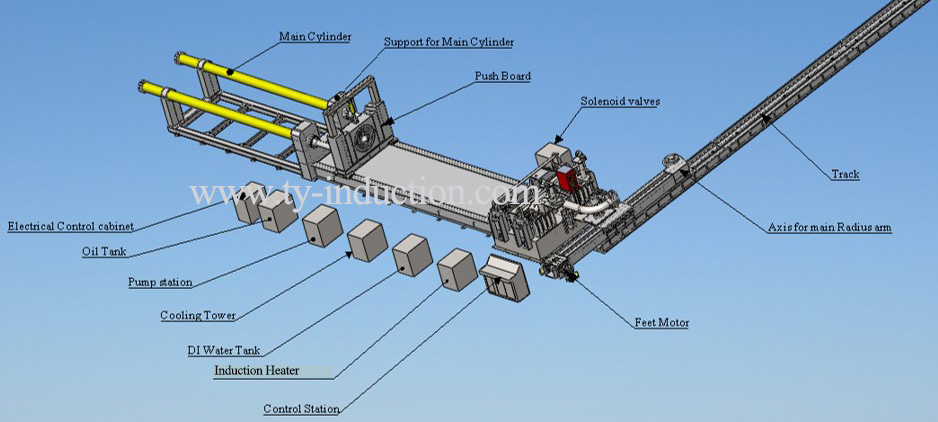Induction Bending
July 21, 2022

Induction bending, also known as high frequency bending, incremental bending or hot bending, is a precisely controlled and efficient metal bending technique. Local heating at the tangent point of the bend using high frequency induced electrical power is applied during the induction bending process. Tubes, pipes, and even structural shapes, including W sections, HSS, and channel sections, can be bent efficiently in an induction bending machine. The process takes over where cold bending methods meet their limitations. When it works, the shape is firmly held by a clamp at the desired radius, which is mounted on a free pivoting arm. An induction coil is placed around the profile/section/pipe and it heats a narrow circumferential section of the profile to between 800 and 1100 degrees Celsius, depending on the material type. Once the proper temperature is reached, the shape is pushed through the inductor by an accurate hydraulic drive system at a carefully controlled and monitored rate, which causes the hot section to form the induction bend at the set radius. At the same time, the cool air and water is sprayed on the area adjacent to the heated zone, to fix the bend shape. The combination of speed, local heat and cooling allows sections to be bent to tighter radii without cross sectional deformation.
Induction Bending Process
The following steps are performed for induction bending of pipe or pipeline system:
● The pre-inspected pipe or pipeline to be bent is placed in the machine bed and clamped hydraulically.
● Around the pipe, induction heating coils and cooling coils are mounted. To ensure uniform heating, the induction coil can be adjusted with a 3-plane movement.
● By adjusting the radius arm and front clamp, the required bend radius can be fixed. There is one pointer to display a correct degree of turning.
● Arc lengths are marked on the pipe. The pipe can be moved slowly whilst the bending force is applied by a fixed radius arm arrangement.
● Once everything is set as required, hydraulic pressure, water level, and switches are inspected and then the induction bending operation is started.
● Upon reaching the required temperature range, the pipe is pushed forward slowly at a speed of 10-40 mm/min, and the operation is stopped when the specified bend angle and pre-determined arc length is reached.
● Just beyond the induction coil, the heated pipe material is quenched using a water spray on the outside surface of the pipe.
● In the next step, the induction bend is removed and sent for inspection and measurement of tolerances.
● The final step for the induction bends is the use of post bend heat treatments for stress relieving, normalizing, etc.
Induction bends are normally produced in standard bend angles (e.g. 45°, 90°, etc.). However, depending on the requirement they can be custom-made to specific bend angles. Compound out-of-plane bends in a single joint of pipe can also be produced. The bend radius for induction bending is specified as a function of the nominal pipe diameter (D) like 5D, 30D, 60D bends, etc. Fig. 1 below provides a schematic diagram of the induction bending mechanism.

Fig. 1 An induction bending system induces localized heat to bend workpieces to tight radii. Image courtesy of Inductaflex.
The important parameters that affect the induction bending process are:
● Pipe Diameter
● Surface Contamination
● Process Parameters like Temperature, Speed, Cooling rate, etc
● Bend Radius
● Bend Angle
● Process Interruptions
● Hardenability of the Pipe Material, etc.
Areas of application
Induction bends find their way in the following industries:
● Onshore and Offshore pipelines in the oil & gas sector
● The refinery, chemical, and petrochemical sector
● Powerplants
● Industrial equipment
● Infrastructure constructions and steel building constructions (a.o. bridges, construction, art objects, roller coasters)
● Offshore energy (a.o. J-tubes, S-jubes)
● Metallurgical industries
● Shipbuilding, etc.
Induction bendable materials
Common materials that can be formed with the induction bending process
Carbon Steel: Low alloyed steel, High alloyed steel, Fine Grain Steel
Stainless Steel: Austenitic, Martensitic, Ferritic, Duplex
Other: Special alloys, Clad Pipe, Aluminum, Titanium
Advantages of Induction bending
The major advantages of induction bending are:
● Lower risk of wall thinning and deformation of the cross-section
● Thin-walled pipes can easily be bent.
● Extremely tight bending radii can be achieved while retaining good cross-sectional dimensions
● Bends can be produced faster than traditional components can be welded
● Uniform hardness and thickness.
● No pipe wrinkles.
● Only a straight pipe is required for induction bending.
● Precise bending radius and angle.
● Diverse bendings: square pipe, flat bar, I-beam, H-beam, channel section, etc.
Hot Products
Contact Us
Enquiry hotline:
+86 135 4128 7190
Email:
Address:
No.18,14th Floor, Building 2, No. 169 Zhongli Road, Banzhuyuan Subdistrict, Xindu District, Chengdu, Sichuan, China, Code:610000
